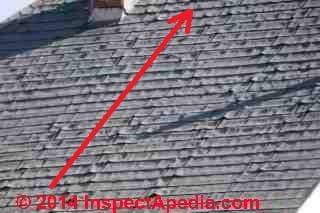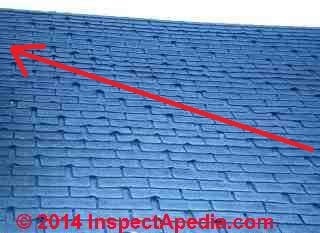 Asphalt Shingle Laddering Wear & Failure Types
Asphalt Shingle Laddering Wear & Failure Types
Types of asphalt shingle roof wear found on roofs installed using the shingle laddering method.
- POST a QUESTION or COMMENT about types of asphalt shingle roof damage caused by or explained by shingle installation in a ladder pattern up the roof slope.
Asphalt shingle laddering wear & failure patterns: this article describes the wear, leak, or failure patterns seen on asphalt shingle roofs that were installed in a ladder-pattern. Some, but not all of these wear conditions can be ascribed to the ladder-pattern of installation. In other photos the ladder pattern-marked shingle wear tells us something else about why the roof is wearing early or unevenly.
This article series describes the installation of asphalt roof shingles in a ladder-approach rather than a multi-course staggered approach to nailing shingles and illustrates the effects of this method on roofs. Our page top photo shows asphalt roof shingles that were installed in the ladder pattern - made very apparent by the early wear and failure of some of areas of the roof - a wear condition that we explain in the text below.
InspectAPedia tolerates no conflicts of interest. We have no relationship with advertisers, products, or services discussed at this website.
- Daniel Friedman, Publisher/Editor/Author - See WHO ARE WE?
Photo-Guide to Asphalt Shingle Laddering Wear & Failure Patterns
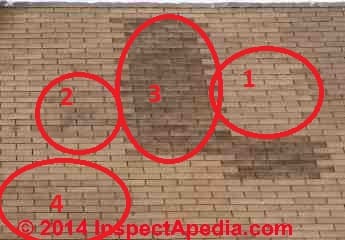 Shingle granule loss due to improper shingle storage or handling
Shingle granule loss due to improper shingle storage or handling
At left is a closer view of the wearing shingles on the asphalt shingle roof shown at page top. The dark shingles in the photo center and lower right show granule loss - early wear or product failure whose cause we can guess.
[Click to enlarge any image]
This article series defines shingle laddering - an installation pattern, and it explains how to identify & evaluate shingles installed in this "ladder pattern".
The information here describes the various sorts of roof leak, wear, and cosmetic issues caused by shingle laddering as an example of something a bit less than the "best" roof installation workmanship. These shingle laddering defects occur on both organic-mat and fiberglass-mat asphalt roof shingles.
Getting back to the asphalt shingle ladder pattern photo show just above, I've marked and numbered four roof areas on this slope of a roof pointed out by my daughter Michelle Friedman and found in Haddonfield, New Jersey. Here is some experienced, informed speculation about four conditions seen on this roof:
- Asphalt shingles wearing well - and normally, showing little granule loss. These are the lighter colored shingles in most of the field of this roof.
Take another look at the page top photo and you'll see these lighter, better-condition shingles appear in various areas of the roof surface, independent of their position on the roof, near the ridge, mid-roof, and near the roof eaves. - Asphalt shingles showing small specific area of granule loss from foot traffic - this looks to me a lot like foot traffic. Stand on this roof and turn your foot on a hot day and you'll rip off granules from the area below your feet.
Someone may have been walking on the roof, or the wear could even have been caused during installation. Click to enlarge the photo and you'll see that the granule loss is on about 3 individual shingles and does not appear elsewhere in this pattern on this roof photo. - Damaged or defective asphalt roof shingles showing early granule loss - these darkest shingles have lost the most granules and are likely to wear out and leak before the rest of the roof covering, precipitating an "early" roof replacement, perhaps several years or more before the end of life of the rest of the roof covering and possibly before the end of the shingle warranty period.
Notice that these shingles appear physically together - they were picked up in a handful - or several handfuls, one for each area where they were nailed onto the roof.
I suspect that all of these damaged shingles (I counted 64 of them) came from the same bundle or shingle bundle trio in a pallet of asphalt shingles that were stored outdoors, exposed to weather (in violation of the manufacturer's instructions), and I suspect that these shingle bundles were on the uppermost or weather-exposed top of the entire pallet of materials.
Exposure of uninstalled roof shingles to the weather by storing them outdoors can cause water to accumulate in the uppermost bundles of material where freeze-thaw cycles can soften and damage the product.
There are other possible explanations but that's my guess and I'm sticking to it unless we can get a sample of the material for laboratory analysis that might offer an alternative explanation such as a manufacturing defect. - Worn asphalt shingles with moderate granule loss, more than item #1 above but less than #3 above. I speculate that these shingles were from the next layer down of shingle bundles on the pallet stored outdoors or that they were also exposed to weather but for less time or in less wearing conditions than their sisters in #3.
For shingles suffering early granule loss due to improper storage or handling, the failure has nothing to do with their installation in a laddering pattern. Rather, the ladder-installation pattern tells us useful information about the sequence of and selection of individual asphalt shingles as they were being nailed to the roof surface.
Shingle Cracking or Thermal Splitting at Roof Locations Determined by Shingle Installation Pattern
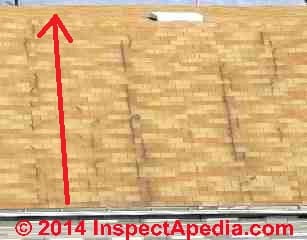 at left you can see long vertical lines of black roofing mastic or sealant that was applied to try to seal cracks or tears in these asphalt roof shingles observed by looking down from the Poughkeepsie NY railroad bridge.
at left you can see long vertical lines of black roofing mastic or sealant that was applied to try to seal cracks or tears in these asphalt roof shingles observed by looking down from the Poughkeepsie NY railroad bridge.
Thermal splitting, cracking, or tearing is an asphalt shingle manufacturing defect discussed in detail at CRACKS & THERMAL SPLITTING in FIBERGLASS SHINGLES.
There we explain that thermal splitting occurs in asphalt roof shingles made without adequate tear resistance, especially when combined with very effective self-sealing shingle tabs (intended to protect against wind-blow-off) and combined again with thermal movement that is more pronounced in areas subject to both freezing winters and hot summers.
Some inspectors opined that the crack pattern on this roof maps 8-foot lengths of roof plywood. Balderdash! You can see thermal splitting occurring in vertical patterns that range in width from one shingle to several individual shingle widths on the roof.
On the roof roof shown above the installation of shingles in a ladder pattern did not cause the thermal splitting problem, but it explains why the thermal splits occur in long vertical lines in the pattern seen in the photograph.
[Click to enlarge any image].
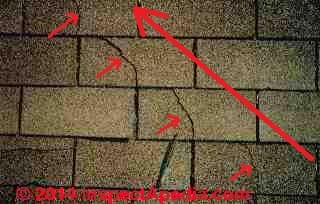 Shown for comparison, at left I include a photograph of thermal splitting occurring along a diagonal on a different roof. These shingles were installed in a standard half-tab offset staggered pattern up the roof rather than in a ladder pattern.
Shown for comparison, at left I include a photograph of thermal splitting occurring along a diagonal on a different roof. These shingles were installed in a standard half-tab offset staggered pattern up the roof rather than in a ladder pattern.
The result is that butt joints march on a diagonal up the roof, and so does thermal splitting in the tabs placed over those butt joints.
While thermal splitting can indeed run vertically up any asphalt shingle roof, why are these shingles splitting along these particular and parallel and long vertical lines? Probably because the ladder pattern creates a vertical line of shingle butt joints that run straight up the roof on alternating shingle courses.
As the self sealing tabs of a single course of shingles glue that tab across the butt joint of a pair of shingles in the course below, that sealed tab is just where the split is most-likely to occur when temperatures cause shrinking or cooling of the entire roof surface. The shingles separated by a butt joint move apart, but the tab glued atop them tears.
Shingle Fishmouthing Occurring in Patterns Mapped to Shingle Ladder Pattern Installation
At below left you can see shingle fishmouthing, a characteristic upwards curved "mouth" occurring roughly in parallel vertical runs up the roof. Click to enlarge the image and you'll see even more interesting evidence. Alternating courses of shingles are producing a fishmouth that is almost exactly 1/2 shingle tab offset from the fishmouthing occurring in shingle courses just above and below.
This pattern of occurrence of fishmouthing is almost certainly mapping the butt joints (below each raised fish mouth) of shingles installed in a shingle ladder installation pattern - shingles installed lapped 1/2 tab to the left, then right, as the roofer worked straight up the roof slope.
Just to illustrate and prove the shingle laddering-fishmouth claim for the roof at above left, in my photo at above right we illustrate fishmouthing occurring on long diagonals on another 3-tab asphalt shingle roof.
These shingles were nailed in the more conventional roof shingle nailing pattern in which shingle courses were offset by 1/2 tab working to the roofer's left or right for six shingle courses at a time.
This increased staggering shows up as follows: choose any fishmouth on the roof and count up-slope until you find another one directly above it. You'll get to six - the number of shingle courses that were nailed in a staggered offset before any shingle butt joint appears over a shingle course below.
Why six? Each of these shingles is comprised of 3 individual tabs separated by slots.
The roofer offsets each successive shingle course 1/2 of a tab (about 6 inches) to the left (or right if she is working to her right) as courses are nailed onto the roof. Do the math - you'll see that offsetting 1/2 a tab at each course will run 6 courses before the pattern repeats.
Shingle laddering does not cause shingle fishmouthing (some mistakenly call this CUPPING ASPHALT SHINGLES, it's not). But it does help confirm an explanation of why shingle fishmouthing occurs by mapping the location of fishmouths in the roof to the location of shingle butt joints.
Fishmouthing is most likely caused by a greater concentration of moisture entering the under-side of an asphalt shingle from below, perhaps from a damp attic or one with excessive moisture condensation.
Where shingle butt joints occur the tab overlying the butt joint will receive more moisture (up through the butt joint gap) than neighboring shingle tabs that are not placed over a shingle butt joint.
...
Continue reading at LADDERING vs STAIR STEPPING SHINGLES or select a topic from the closely-related articles below, or see the complete ARTICLE INDEX.
Suggested citation for this web page
LADDERED SHINGLE FAILURES & WEAR at InspectApedia.com - online encyclopedia of building & environmental inspection, testing, diagnosis, repair, & problem p
INDEX to RELATED ARTICLES: ARTICLE INDEX to BUILDING ROOFING
Or use the SEARCH BOX found below to Ask a Question or Search InspectApedia
Ask a Question or Search InspectApedia
Try the search box just below, or if you prefer, post a question or comment in the Comments box below and we will respond promptly.
Search the InspectApedia website
Note: appearance of your Comment below may be delayed: if your comment contains an image, photograph, web link, or text that looks to the software as if it might be a web link, your posting will appear after it has been approved by a moderator. Apologies for the delay.
Only one image can be added per comment but you can post as many comments, and therefore images, as you like.
You will not receive a notification when a response to your question has been posted.
Please bookmark this page to make it easy for you to check back for our response.
IF above you see "Comment Form is loading comments..." then COMMENT BOX - countable.ca / bawkbox.com IS NOT WORKING.
In any case you are welcome to send an email directly to us at InspectApedia.com at editor@inspectApedia.com
We'll reply to you directly. Please help us help you by noting, in your email, the URL of the InspectApedia page where you wanted to comment.
Citations & References
In addition to any citations in the article above, a full list is available on request.
- Our recommended books about building & mechanical systems design, inspection, problem diagnosis, and repair, and about indoor environment and IAQ testing, diagnosis, and cleanup are at the InspectAPedia Bookstore. Also see our Book Reviews - InspectAPedia.
- In addition to citations & references found in this article, see the research citations given at the end of the related articles found at our suggested
CONTINUE READING or RECOMMENDED ARTICLES.
The company has published online a sample Tornado Report
"Residential Wind Damage Evaluation", Wind Damage Sample, found at http://www.ontherockeng.com/Sample%20Tornado%20Report.pdf
CONTINUE READING or RECOMMENDED ARTICLES.
- Carson, Dunlop & Associates Ltd., 120 Carlton Street Suite 407, Toronto ON M5A 4K2. Tel: (416) 964-9415 1-800-268-7070 Email: info@carsondunlop.com. Alan Carson is a past president of ASHI, the American Society of Home Inspectors.
Thanks to Alan Carson and Bob Dunlop, for permission for InspectAPedia to use text excerpts from The HOME REFERENCE BOOK - the Encyclopedia of Homes and to use illustrations from The ILLUSTRATED HOME .
Carson Dunlop Associates provides extensive home inspection education and report writing material. In gratitude we provide links to tsome Carson Dunlop Associates products and services.


